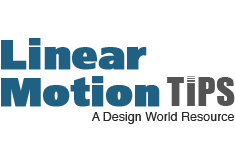Screw assemblies are generally preferred over belts or linear motors in vertical applications. This is because a screw will prevent the load from catastrophically crashing if there’s a loss of power to the motor. But a vertical load can still cause a screw to back drive, allowing the load to drop, albeit at a slightly more “controlled” rate, since it has to overcome the (in)efficiency of the screw, the system friction, and the screw’s lead angle.
Lead screws and ball screws have different tendencies to back drive—lead screws typically have a very low chance of back driving, whereas ball screws are more likely to allow the load to fall. This disparity comes down to efficiency. A lead screw’s low efficiency, which is often considered a negative performance factor, can, in a vertical application, prevent the nut from freely rotating under the weight of the load. And if the lead of the screw is small, the assembly will be even less likely to back drive. (A rule of thumb to prevent back driving is to use a lead that is less than 1/3 the diameter of the screw.)
On the other hand, the high efficiency of a ball screw drive makes it more likely than a lead screw to back drive in a vertical application. But if the application requires a ball screw for positioning accuracy, load capacity, or rigidity, there is a way for designers to determine the likelihood that back driving will occur.
First, calculate the back drive torque, which is a factor of the load, the screw lead, and the screw efficiency:
Tb = back driving torque (Nm)
F = axial load (N)
P = screw lead (m)
η2 = reverse efficiency (0.8 to 0.9 for ball screws)*
*Efficiency when back driving is typically less than the efficiency for normal operation. Be sure to check the manufacturer’s specification for the back driving efficiency.
To determine if this torque will induce back driving, compare it to the friction forces in the assembly—the drag torque of the ball nut, the friction of the seals, and the friction of the end bearings. If the back driving torque is less than the friction of the assembly, the load is unlikely to cause the screw to back drive.
Below is an example, assuming a 16×10 ball screw assembly with a fixed-floating bearing arrangement and a load of 100 N:
This ball screw assembly has the following friction torques (taken from the manufacturer’s catalog):
Ball nut = 0.03 Nm
End seals = 0.08 Nm
End bearings = 0.15 Nm
Total system torque = 0.26 Nm
In this example, the back driving torque of 0.13 Nm is much less than the total friction torque of 0.26 Nm for the screw assembly, which means that back driving is unlikely.
Despite these calculations, safety is the most important consideration in a vertical application. Knowing the probability that a load will cause a screw assembly to back drive is not a “get out of jail free” card to disregard fail-safe mechanisms. Instead, it should help designers choose the appropriate safety mechanism, such as a supplementary brake or a counterweight, to prevent damage to equipment or injury to personnel.


Leave a Reply
You must be logged in to post a comment.